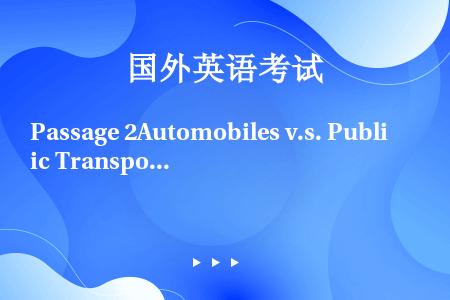 问答题
问答题
Passage 2
Automobiles v.s. Public Transport Public transport plays a central role in any efficient urban transport system. In developing countries, where at least 16 cities are expected to have more than 12 million people each by the end of this decade, failing to give priority to public transport would be disastrous.
The term “public transport” covers many different types of vehicles, but most commonly refers to buses and trains. Rail services fall into four major categories: rapid rail (also called the underground, tube, metro, or subway), which operates on exclusive rights of way in tunnels or on elevated tracks; trams, which move with other traffic on regular streets; light rail, which is a quieter, more modern version of trams that can run either on exclusive rights of way or with other traffic; and suburban or regional trains, which connect a city with surrounding areas.
The recent trend in many cities is toward light rail over “heavy” rapid rail systems. Whereas metros require exclusive rights of way, which often means building costly elevated or underground lines and stations, light rail can be built on regular city streets, which means no extra expenses.
The concept of public transport also includes organized car pools, in which several people share the cost of tiding together in the same private automobile. For U.S. commuters in areas with inadequate bus and train services, this is the only “public” transport option. But even where other systems are comprehensive, there is vast potential for car pooling; recent research shows that in cities the world over, private cars during commuting hours on average carry just 1.2-1.3 persons per vehicle.
Public transport modes vary in fuel use and emissions and in the space they require, but if carrying reasonable numbers of passengers, they all perform better than single occupant private cars on each of these counts.
Although energy requirements vary according to the size and design of the vehicle and how many people are on board, buses and trains require far less fuel per passenger for each kilometre of travel. In the United States, for example, a light rail vehicle needs an estimated 640BTUs of energy per passenger per kilometre; a city bus would use some 690BTUs per passenger per kilometre; and a car pool with four occupants 1,140BTUs. A single occupant automobile, by contrast, bums nearly 4, 580BTUs per passenger per kilometre.
The pollution savings from public transport are even more dramatic. Since both rapid and light rail have electric engines, pollution is measured not from the motor exhaust, but from the power plant generating electricity, which is usually located outside the city, where air quality problems are less serious. For typical U.S. commuter routes, rapid rail emits 30 grams of nitrogen oxides for every 100 kilometres each rail passenger travels, compared with 43 grams for light rail, 95 grams for transit buses, and 128 grams for single occupant automobiles. Public transport’s potential for reducing hydrocarbon and carbon monoxide emissions is even greater.
Although diesel buses especially in developing countries can be heavy polluters, existing technologies, such as filters, can control their exhaust. Buses can also run on less polluting fuels such as propane (used in parts of Europe) and natural gas (used in Brazil and China). Test buses in the Netherlands that run on natural gas are estimated to emit 90 percent less nitrogen oxide and 25 percent less carbon monoxide than diesel engines do.
In addition to reducing fuel consumption and pollution, public transport saves valuable city space. Buses and trains carry more people in each vehicle and, if they operate on their own rights of way, can safely run at much higher speeds. In other words, they not only take up less space but also occupy it for a shorter time. Thus, comparing ideal conditions for each mode in one lane of traffic, an underground metro can carry 70, 000 passengers past a certain point in one hour, light rail can carry up to 35, 000 people, and a bus, just over 30, 000. By contrast, a lane of private cars with four occupants each can move only about 8, 000 people an hour, and without such carpooling the figure is, of course, far lower.
The availability and use of public transport vary widely in cities around the globe. Since variations in distances and city densities affect the total kilometres of travel, the annual number of trips each person takes by public transport provides a better standard for comparing its importance in various cities. The range of frequency of public transport use is shown in Table (see page 73).
Urban public transport has long been a government priority in Western Europe. All major cities there have high car ownership, but well-developed bus and rail systems are available, and overall public transport typically accounts for between 20 and 30 percent of passenger kilometres. In recent years, several large cities have stepped up their commitment to public transportation, combining further investments with complementary policies to restrict auto use.
Public transport also plays an important role in urban areas of developing countries. In many cities in Asia, Latin America, and Africa, buses make 50-80 percent of all motorized trips. Buses are sometimes hopelessly overcrowded; it is not uncommon to see several riders clinging to the outside. Yet most cities in developing countries have lower public transport use per person than those in Western Europe, reflecting the inability of small bus fleets to keep up with population growth.
Among the world’s major cities, those in Australia and the United States make the least use of alternatives to the private car. Indeed, less than 5 percent of U.S. trips are by public transport, but in some cities such as New York City and Chicago, where service is provided extensively, it is used heavily. Indeed, nearly one quarter of the entire country’s public transport trips are in New York City.
* BTUs: British Thermal Units (a measure of energy consumed)
Dependence on public transport in selected cities, 1989![]()
*trips per person per year
Answer the questions below.
Choose NO MORE THAN THREE WORDS from the passage for each answer.
Write your answers in boxes 16-20 on your answer sheet.
1. What is a factor that makes light rail preferable to rapid rail?
2. What is the average number of people in automobiles during commuting hours?
3. Where is the pollution measured from?
4. In which aspect does rapid rail outperform light rail?
5. What proportion of passenger kilometres is undertaken by private automobile in Western Europe?
发布日期:2022-07-05


题王网让考试变得更简单
扫码关注题王,更多免费功能准备上线!

此试题出现在
按照受法律保护的方式,技术转让的客体主要有两大类:一是专利技术,二是专有技术。
患者,男性,49岁,因高血压7年入院。患者自7年前即出现头晕、头痛,血压增高20.0/14.7kPA左右,曾多次在外院以高血压病诊治(具体用药不详),疗效不佳,现去某院就诊,为进一步明确诊断,拟来我科行肾上腺皮质显像。下列不是肾上腺皮质显像剂的是()。
对企业存货进行盘点,审计人员抽点的样本一般不低于存货总量的()。
保监局应当依据()等监测指标和日常监管中掌握的信息对辖区内保险公司分支机构进行分类。
服务前期评估有需求评估和方案评估两种。下列关于服务前期方案评估的过程,说法正确的有()。
空调控制柜温控器双显制冷:上限28℃----下限24℃
在各种生物、心理以及社会环境因素的影响下,大脑功能失调,导致认知、情感、意志和行为等精神活动出现不同程度障碍为临床表现的疾病,称为()。
美国、英国、法国、德国、日本、意大利、加拿大七国为研究经济形势、协调政策而召开的首脑会议,简称G7。由于下列哪个国家的加入,此组织改名为G8?( )
某机电工程公司总包了600MW机组的火电工程项目,合同规定机炉电设备和主要物资由业主采购,监理单位由业主委派,所有施工、设施、设备和物资等场地均由业主提供和租赁;该机电工程公司考虑专业化管理,将大件设备的运输工作分包给了专门的物资管理公司,将机炉电等工程的试运行委托给了试验所等。在运输的设备中,汽机设备中低压缸由散件供货,中、高压缸由整体供货,鉴于汽机设备途径多省市,且又超宽超高和道路状况,无法由公路运输至施工现场,只有采用从制造厂陆路运输到码头,再从码头水路运输至所在地码头,最后从所在地码头陆路运输到施工现场。经物资管理公司的多方协调,以及施工现场道路作业,使得运输工作顺利完成。当低压缸各段散件运至工地后,机电公司负责现场组合安装。由于在低压下缸组合过程中,对低压下缸中心与汽缸前后汽封洼窝中心的找中心测量不到位,使得在低压缸组合完成后,吊入转子安装时,汽缸的汽封中心和转子中心出现了较大的偏差,好在不是设备质量问题,经重新找中心调整处理误差消除了。问题:与该机电工程公司有合同关系且需要协调的单位有哪些?
影响沥青混合料高温稳定性的主要因素有()。
非专业可以考出版资格证书吗?有哪些报考条件?
关于BEC考试有哪些备考建议?
为什么要考BEC?
有哪些学习商务英语的好方法?
商务英语考试(BEC)难不难?
都说GRE考试难,那么它究竟难在哪?
什么是GRE考试?
雅思考试在即,如何快速备考?
说说雅思考试那些事
雅思5.5相当于CET几级的水平?
Passage 2Automobiles v.s. Public Transport Public transport plays a central rol...
According to the passage, why are the public in eastern Germany especially furio...
According to the passage, why is the happiness of the general public a difficult...
Passage 13Questions 8—12 ● Read the article below about public relations. ● Ch...
According to the passage, many important persons in public life and the big corp...
According to the passage, many important persons in public life and the big corp...
Passage 2 Public goods are those commodities from whose enjoyment nobody can be...
______
As automobiles replaced horses as the primary means of transportation, it was wi...
If increased income is spent on more and larger automobiles, larger houses, and ...

